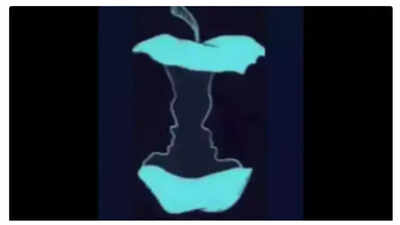Optical illusions are more than just amusing brain teasers; they provide a fascinating glimpse into how our minds work. These visual puzzles challenge our perception and can reveal surprising aspects of our personality. This particular illusion, popularized by social media user Marina Winberg, presents a simple yet revealing choice: do you see an eaten apple or two faces? Your initial response could uncover some deep-seated truths about your character.

Optical illusions occur because the brain sometimes misinterprets the information received from the eyes. This happens when the visual data conflicts with the brain's understanding, leading to the perception of something that isn't truly there.
Take a moment to study the image carefully. What stands out to you first?
According to Marina Winberg, if you immediately perceive two faces (a man and a woman looking at each other), it suggests: “You’re a logical, analytical thinker with strong morals. You think before you act, value stability, and solve problems creatively— but sometimes, curiosity gets the best of you!”
Alternatively, if your eyes are drawn to the apple core, it implies: “You’re intuitive, emotionally aware, and great at reading subtle cues. You know the right thing to say, but often stay quiet. Stability matters to you, and you protect what’s important.”
Optical illusions are categorized into three main types:
Literal Illusions: These illusions occur when the brain pieces together elements of an image to create a perception that doesn't actually exist in the image itself. A classic example is the Rubin vase, which can be seen as either two faces or a vase.
Physiological Illusions: These illusions result from overstimulation of the visual system. Excessive exposure to light, color, or movement can lead to afterimages or the perception of motion in a still image.
Cognitive Illusions: These illusions rely on the brain's subconscious interpretations. The Müller-Lyer illusion, where lines appear to be different lengths due to the surrounding shapes, is a prime example of a cognitive illusion.
This simple optical illusion provides an entertaining yet insightful way to explore the complexities of human perception and how our brains interpret the world around us. What did you see first?
Newer articles
Older articles
 Greg Chappell: Rishabh Pant is Revolutionizing Cricket with Unconventional Batting Style
Greg Chappell: Rishabh Pant is Revolutionizing Cricket with Unconventional Batting Style
 Earth's Spin Accelerates: Scientists Predict Possible Negative Leap Second by 2029
Earth's Spin Accelerates: Scientists Predict Possible Negative Leap Second by 2029
 Samsung Galaxy A35 5G and A55 5G: Official Pricing and Availability Announced
Samsung Galaxy A35 5G and A55 5G: Official Pricing and Availability Announced
 3 Secrets to a Longer, Healthier Life: Lessons From Japan's Longevity Village
3 Secrets to a Longer, Healthier Life: Lessons From Japan's Longevity Village
 Silent Signals: Heed These Early Heart Attack Warning Signs
Silent Signals: Heed These Early Heart Attack Warning Signs
 Prediabetes Warning: 5 Subtle Signs Your Body Could Be Signaling High Blood Sugar
Prediabetes Warning: 5 Subtle Signs Your Body Could Be Signaling High Blood Sugar
 Gujarat Cricket Association Set to Launch New T20 League, Aiming to Boost Local Talent
Gujarat Cricket Association Set to Launch New T20 League, Aiming to Boost Local Talent
 Raducanu Shuts Down Alcaraz Dating Rumors, Confirms US Open Mixed Doubles Pairing
Raducanu Shuts Down Alcaraz Dating Rumors, Confirms US Open Mixed Doubles Pairing
 'The Traitors' Star Apoorva Mukhija Accuses Sudhanshu Pandey of Misogyny and Abusive Language After On-Screen Criticism
'The Traitors' Star Apoorva Mukhija Accuses Sudhanshu Pandey of Misogyny and Abusive Language After On-Screen Criticism
 Prasidh Krishna Vows to Sharpen Bowling Accuracy and Cut Run Rate in Upcoming Tests
Alternatively (shorter):
Prasidh Krishna Targets Length Improvement, Lower Economy After Costly Outing
Prasidh Krishna Vows to Sharpen Bowling Accuracy and Cut Run Rate in Upcoming Tests
Alternatively (shorter):
Prasidh Krishna Targets Length Improvement, Lower Economy After Costly Outing